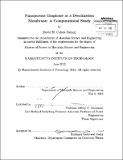Nanoporous graphene as a desalination membrane : a computational study
Author(s)
Cohen-Tanugi, David H. (David Henri Michaël)
DownloadFull printable version (3.823Mb)
Other Contributors
Massachusetts Institute of Technology. Dept. of Materials Science and Engineering.
Advisor
Jeffrey C. Grossman.
Terms of use
Metadata
Show full item recordAbstract
With conventional water sources in short and decreasing availability, new technologies for water supply have a crucial role to play in addressing the world's clean water needs in the 21st century. In this thesis, we examine how nanometer-scale pores in single-layer freestanding graphene can effectively filter NaCl salt from water. Using classical molecular dynamics, we report the desalination performance of such membranes as a function of pore size, chemical functionalization, and applied pressure. Our results indicate that the membrane's ability to prevent the salt passage depends critically on pore diameter, with pores in the 0.7-0.9 nm range allowing for water flow while blocking ions. Further, an investigation into the role of chemical functional groups bonded to the edges of graphene pores suggests that commonly occurring hydroxyl groups can roughly double the water flux thanks to their hydrophilic character. The increase in water flux comes at the expense of less consistent salt rejection performance, which we attribute to the ability of hydroxyl functional groups to substitute for water molecules in the hydration shell of the ions. Overall, our results indicate that the water permeability of this material is several orders of magnitude higher than conventional reverse osmosis membranes, and that nanoporous graphene may have a valuable role to play for water purification.
Description
Thesis (S.M.)--Massachusetts Institute of Technology, Dept. of Materials Science and Engineering, 2012. Cataloged from PDF version of thesis. Includes bibliographical references (p. 19-21).
Date issued
2012Department
Massachusetts Institute of Technology. Department of Materials Science and EngineeringPublisher
Massachusetts Institute of Technology
Keywords
Materials Science and Engineering.